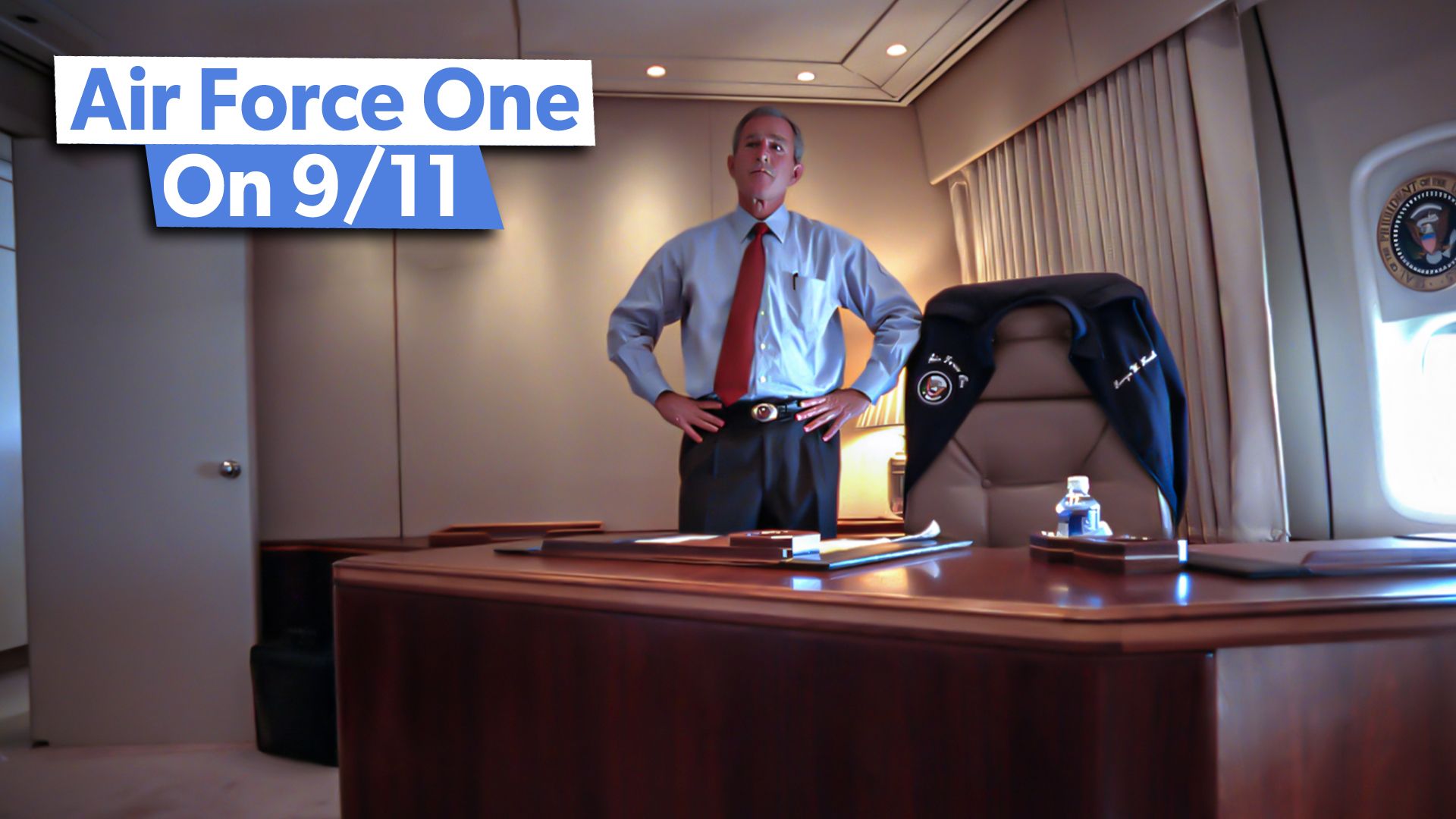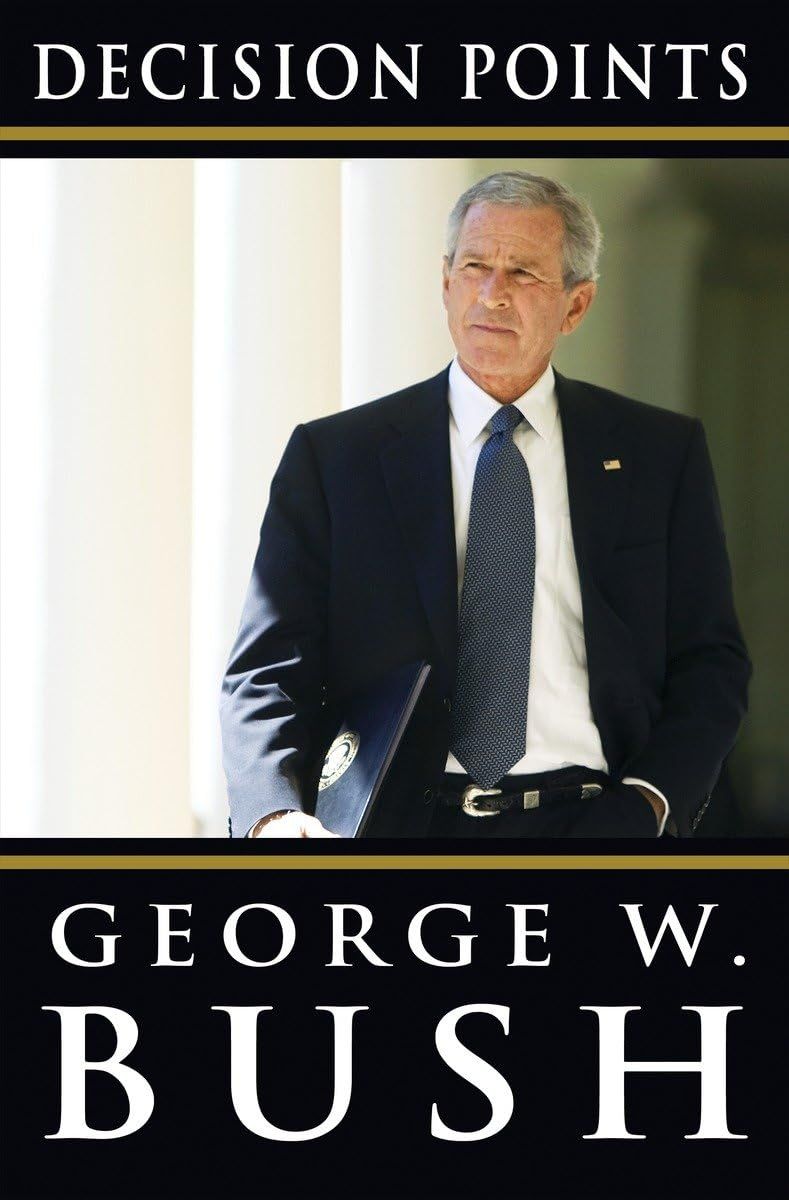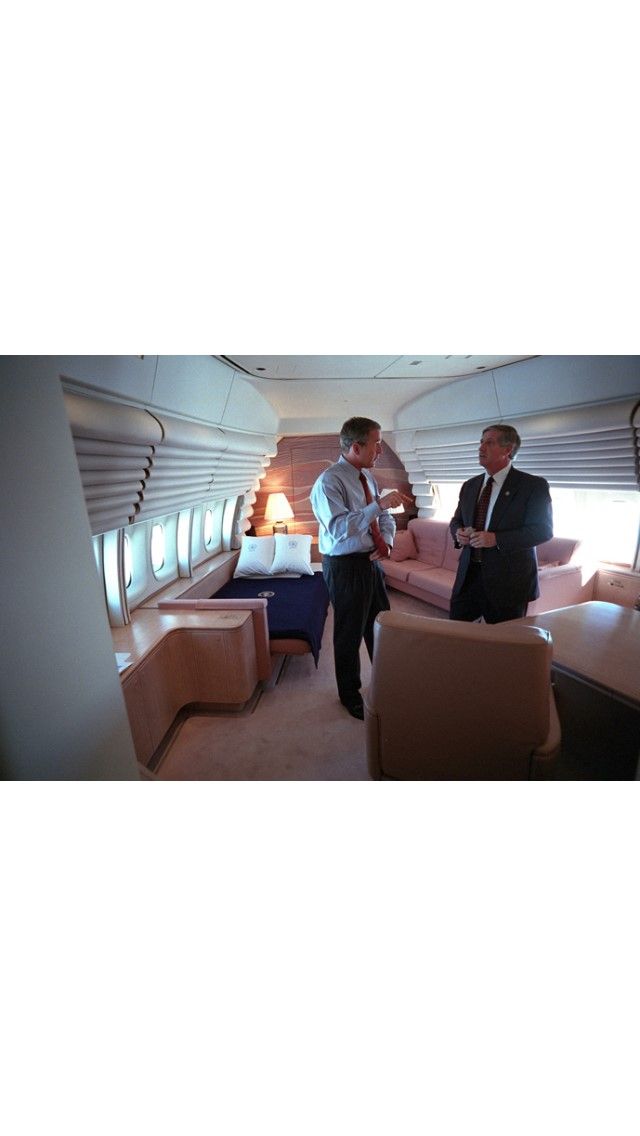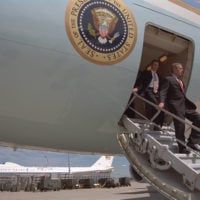Summary
- President Bush made tough wartime decisions on ROEs and where to land Air Force One after the attacks.
- Air Force One’s technological limitations frustrated the POTUS during the 9/11 crisis.
- After stops at Barksdale AFB and Offut AFB, the President returned to DC and addressed the nation post-attack.
On the fateful morning of Tuesday, September 11, 2001, then-President of the United States (POTUS) George Walker Bush awoke before dawn in his suite at the Colony Beach and Tennis Resort near Sarasota, Florida. He started his day by reading his Bible and going downstairs for a jog around the resort’s golf course. Born July 6, 1946, President Bush was also known as “Dubya” and “Bush 43” to distinguish him from his father, former POTUS George Herbert Walker Bush “Bush 41”. Both were former military aviators.
Learn more about the warbird types flown by Bush 41 and Bush 43, respectively.
At 8:00am a.m. that morning, Mr. Bush received his Presidential Daily Briefing from (in the President’s own words) “a bright CIA analyst named Mike Morrell” which “covered Russia, China, and the Palestinian uprising in the West Bank and Gaza Strip.” Shortly after the PDB concluded, Pres. Bush and his retinue visited Emma E. Booker Elementary School to highlight education reform. En route to the school, his Senior Advisor, Karl Rove, informed him that an airplane had crashed into the World Trade Center. At that moment, the President assumed it must’ve been a horrible accident.
During this school visit, the President was reading the short story The Pet Goat by Siegfried “Zig” Engelmann and Elaine C. Bruner to an assembled group of second-graders when his Chief of Staff, Andy Card, whispered the horrifying follow-up news in POTUS’s ear:
“A second plane has hit the second tower. America is under attack.”
Now knowing that his country was on a wartime footing, President Bush cut his school visit short and was soon on his way back to his VC-25 executive jet, better known as Air Force One.
[PLACEHOLDER] hours later
A key source of information for this article is former President Bush’s own autobiography/memoir, Decision Points, which was first published in 2010. I highly recommend it. I understand that even some of Mr. Bush’s harshest critics during his eight years in office praised the book.
Now, to commemorate the 23rd anniversary of the 9/11 attacks, Simple Flying now attempts to tell the story in pictures of what it was like aboard Air Force One that day.
President Bush arrives aboard Air Force One
To quote President Bush again:
“The shift to wartime was visible at the airport. Agents carrying assault rifles surrounded Air Force One. Two of the flight attendants stood at the top of the stairs. Their faces betrayed their fear and sadness. I knew millions of Americans would be feeling the same way. I hugged the flight attendants and told them it would be okay.”
“I called [then-Vice President] Dick Cheney as Air Force One climbed rapidly to forty-five thousand feet, well above our typical cruising altitude. He had been taken to the underground Presidential Emergency Operations Center—the PEOC—when the Secret Service thought a plane might be coming at the White House. I told him that I would make decisions from the air and count on him to implement them on the ground.”
Two tough decisions
From there, President Bush made two tough but necessary choices in short order:
- Rules of engagement (ROEs) for the Combat Air Patrols (CAPs), i.e., teams of fighter jets assigned to intercept unresponsive aircraft over New York City and Washington DC
- Where to land Air Force One after the abrupt departure from Florida.
Regarding the first decision, the former President says:
“I told Dick that our pilots should contact suspicious planes and try to get them to land peacefully. If that failed, they had my authority to shoot them down. Hijacked planes were weapons of war. Despite the agonizing costs, taking one out could save countless lives on the ground. I had just made my first decision as a wartime commander in chief.”
This CAP mission would soon come to be known as Operation Noble Eagle.
As for the second decision:
“I felt strongly that we should return to Washington. I wanted to be in the White House to lead the response. It would reassure the nation to see the president in the capital that had been attacked…But as much as I wanted to get back, I recognized that part of my responsibility was to ensure the continuity of government. It would be an enormous propaganda victory for the enemy if they took out the president. The military aide and Secret Service agents recommended that we divert the plane to Barksdale Air Force Base in Louisiana, where we could refuel. I relented. A few minutes later, I felt Air Force One bank hard to the west.”
Air Force One technology woes lead to POTUS frustrations
Photo: White House/Eric Draper (via George W. Bush’s “Decision Points”)
In Decision Points, the caption for this photo reads:
“Venting my frustrations to Andy Card.”
What sort of frustrations was the President venting here? As he explains:
“‘I had been trying to reach Laura [the First Lady, i.e, his lovely wife] all morning. She had been scheduled to testify before a Senate committee in support of our education initiative around the same time the planes struck the World Trade Center towers. I placed several calls, but the line kept dropping. I couldn’t believe that the president of the United States couldn’t reach his wife in the Capitol Building. ‘What the hell is going on?’ I snapped at Andy Card. I finally connected with Laura as Air Force One descended into Barksdale. Laura’s voice is always soothing, but it was especially comforting to hear that day. She told me she had been taken to a safe location by the Secret Service. I was very relieved when she told me she had spoken to [daughters] Barbara and Jenna, both of whom were fine.'”
That wasn’t the only source of in-flight communication technology foibles causing frustration for Mr Bush that awful day. As shocking as it may seem to us now, the plane had no satellite television at the time. Therefore, the President and his in-flight team depended on whatever local feeds they could pick up. The screen would dissolve into static after a few minutes on a given station.
That issue wasn’t resolved for another two decades. On September 09, 2021, Elizabeth Neus wrote in an article for FedTech:
“The airborne White House has made a huge technological leap since then. Twenty years later, one of the world’s most famous airplanes has cable TV, internet connectivity, upgraded electrical systems and defense mechanisms that no one will talk about.”
Offut AFB, Nebraska
After making that aforementioned fueling stop at Barksdale AFB, Louisiana, Air Force One proceeded to Offut AFB, Nebraska (in the vicinity of Omaha), the home of US Strategic Command (USSTRATCOM), which had secure housing space and arguably even more importantly in light of the aforementioned in-flight common woes of Air Force One, reliable communications. Upon arrival, the President was taken to the base command center, which was filled with military officers who, by eerie coincidence, had been taking part in a planned exercise.
It wasn’t until 6:30 pm Eastern Daylight Time that evening that Air Force One finally touched back down at Andrews AFB, Maryland, facilitating the President’s return to the White House and, more specifically, the Oval Office, whereupon he would address the nation, saying:
“Today, our fellow citizens, our way of life, our very freedom, came under attack in a series of deliberate and deadly terrorist attacks…We will make no distinction between the terrorists who committed these acts and those who harbor them…[citng Psalm 23] ‘Even though I walk through the valley of the shadow of death, I will fear no evil, for You are with me.'”
Just under a month later, Operation Enduring Freedom (OEF), America’s first round of offense in the Global War on Terror (GWOT), commenced. The world would never be the same.



